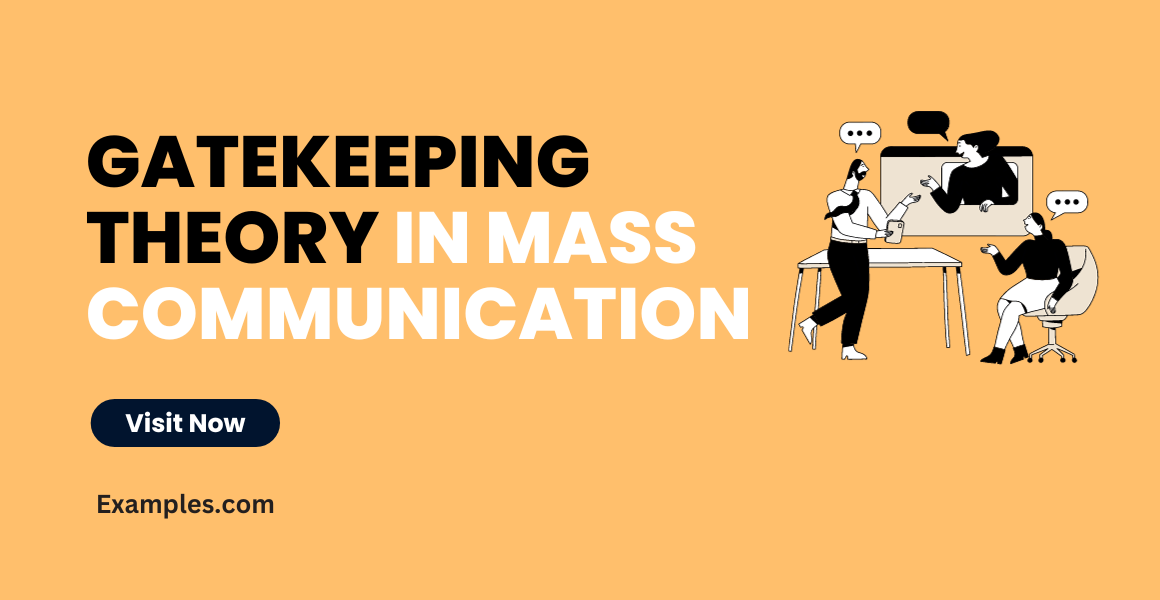29+ Gatekeeping Theory in Mass Communication Examples
Dive into the world of Mass Communication with our comprehensive guide on Gatekeeping Theory. Understand how media gatekeepers control what information reaches the public and the significant role this plays in shaping societal narratives. This guide, enriched with real-life examples and scenarios, highlights the Main Functions of Mass Communication and offers practical tips for both media professionals and students.
What is Gatekeeping Theory in Mass Communication?
Gatekeeping Theory in Mass Communication is a critical concept that explains how information is filtered and selected for public consumption. In simple terms, gatekeeping involves decision-making processes about what news, information, or entertainment reaches an audience. These decisions are made by individuals or groups, commonly known as gatekeepers, who have control over the flow of information.
In the realm of mass communication, gatekeepers can be news editors, journalists, media executives, or algorithms in digital platforms. They decide what stories are told, how they are framed, and whose voices are heard. This theory is pivotal in understanding the dynamics of Mass Communication in Broadcasting and Social Media Mass Communication, where the power to influence public opinion and shape cultural norms resides significantly with the gatekeepers.
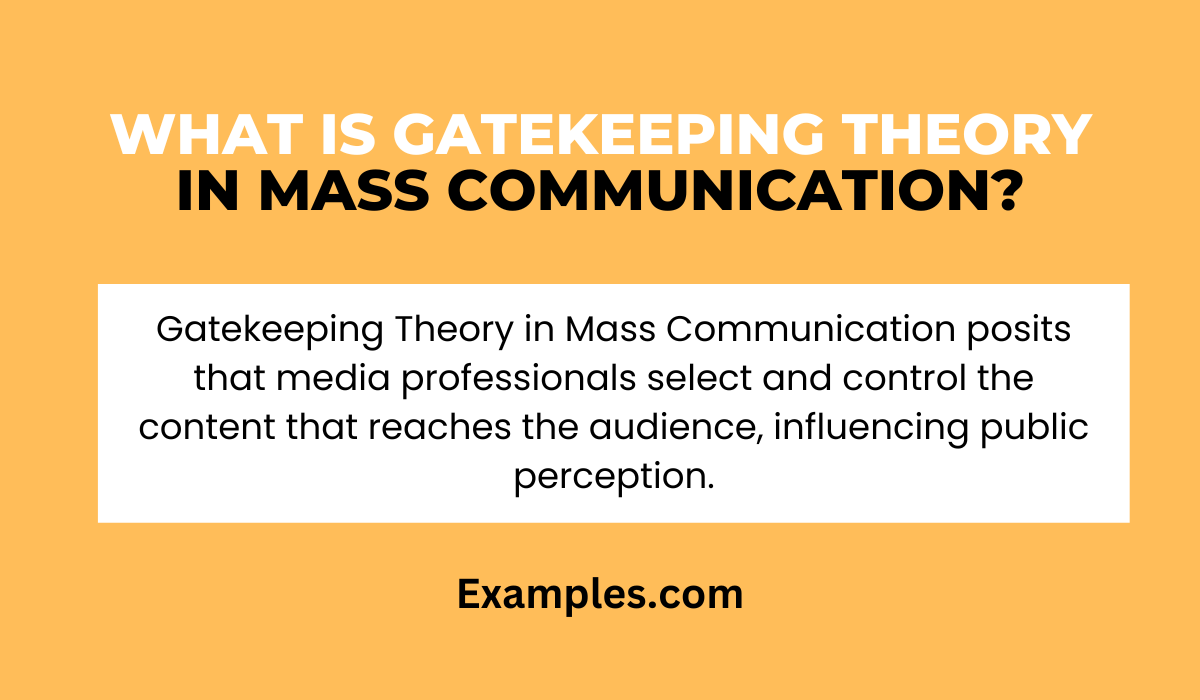
History of Gatekeeping Theory in Mass Communication
The concept of Gatekeeping Theory in Mass Communication was first introduced by social psychologist Kurt Lewin in 1947. Initially applied to food choices within a family, the theory later evolved to describe the media’s role in controlling information flow. It gained prominence in the context of mass media, particularly in journalism and broadcasting, where decision-makers or ‘gatekeepers’ determine which information is published or broadcasted and which is not.
What is the Best Example of Gatekeeping Theory in Mass Communication?
The most illustrative example of Gatekeeping Theory in mass communication is the process of news selection and presentation by media houses. Editors and journalists act as ‘gatekeepers’, deciding what news to report and how to frame it. This filtering shapes public perception, highlighting the gatekeepers’ power in influencing what information reaches the audience.
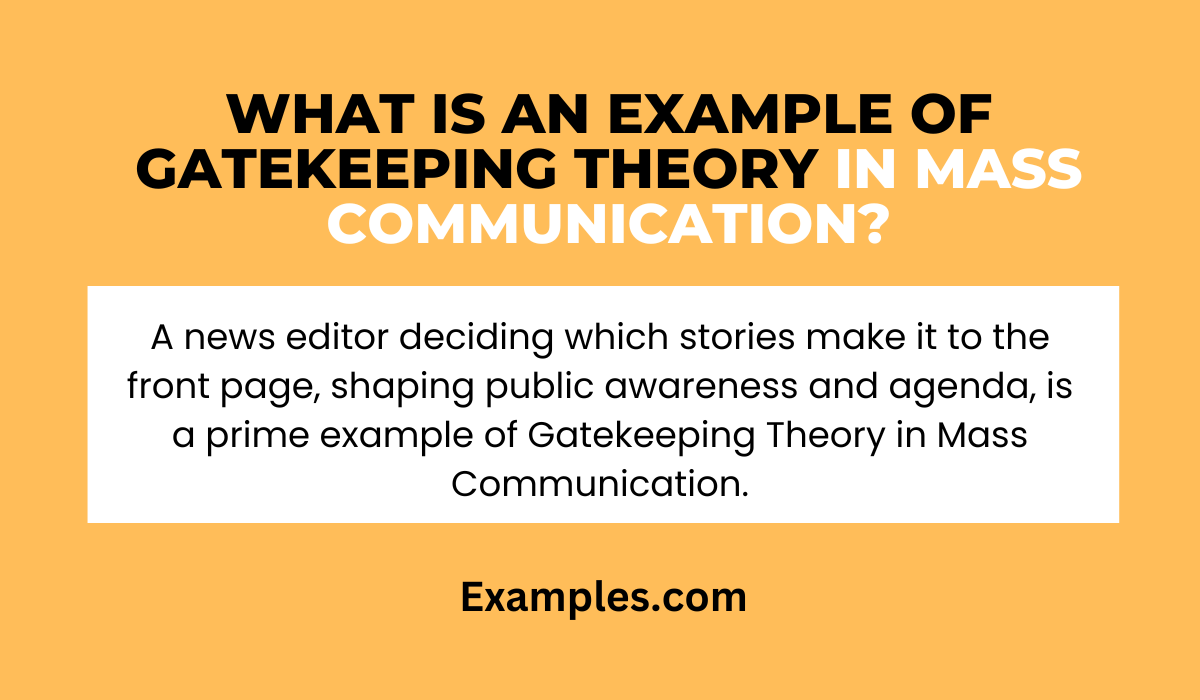
30 Examples of Gatekeeping Theory in Mass Communication
Gatekeeping Theory in Mass Communication reveals how information is filtered and disseminated to the public. This theory is crucial in understanding Mass Communication in Real Life and the Roles of Media in Society. It highlights the power dynamics in media, shaping public perception through selective exposure.
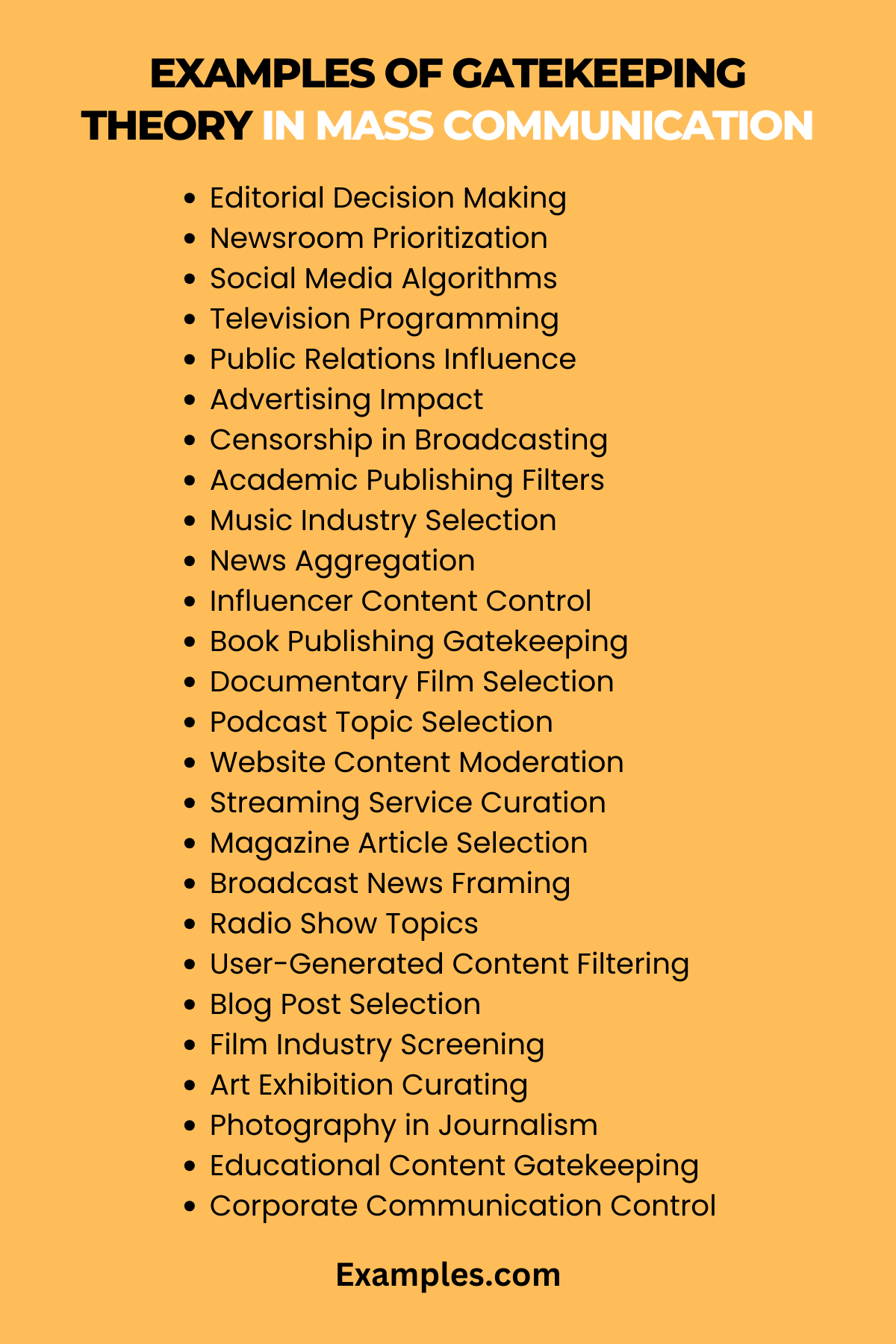
- Editorial Decision Making: Editors decide which news stories to publish.
Example: “This story aligns with our audience’s interest, let’s prioritize it for the morning edition.” - Newsroom Prioritization: Journalists rank news based on perceived public interest.
Example: “Given its impact, this event should lead our news segment tonight.” - Social Media Algorithms: Algorithms determine what content users see.
Example: “Our post’s engagement rate will influence its visibility on social media feeds.” - Television Programming: TV networks select shows based on audience demographics.
Example: “Our prime-time slots should feature shows that resonate with our key demographic.” - Public Relations Influence: PR professionals shape news through press releases.
Example: “We need to craft our press release to maximize media pick-up.” - Advertising Impact: Advertisers influence content through sponsored content.
Example: “This sponsored segment should align with our brand values and audience interests.” - Censorship in Broadcasting: Regulators or networks censor content deemed inappropriate.
Example: “This segment needs to be edited to comply with broadcasting standards.” - Academic Publishing Filters: Journals select research based on relevance and quality.
Example: “Your study’s innovative approach makes it a strong candidate for publication.” - Music Industry Selection: Record labels decide which artists to promote.
Example: “Her unique sound fits the current market trend; let’s push her album release.” - News Aggregation: Curators select articles for news aggregator platforms.
Example: “These topics are trending; let’s feature them on our homepage.” - Influencer Content Control: Influencers curate content to maintain their image.
Example: “This post aligns with my brand and will resonate with my followers.” - Book Publishing Gatekeeping: Publishers select manuscripts for publication.
Example: “This manuscript has a strong narrative that will appeal to our readers.”

- Documentary Film Selection: Producers choose subjects that have mass appeal.
Example: “This topic is both engaging and informative, ideal for our next documentary.” - Podcast Topic Selection: Podcast hosts choose themes based on audience interest.
Example: “Our listeners enjoy tech topics, so let’s focus our next episode on emerging technologies.” - Website Content Moderation: Moderators remove inappropriate user-generated content.
Example: “This comment violates our community guidelines and must be removed.” - Streaming Service Curation: Platforms select shows and movies based on viewer preferences.
Example: “Our data shows a rise in sci-fi popularity; let’s add more to our catalog.” - Magazine Article Selection: Editors choose articles that fit their readership’s interests.
Example: “This article perfectly matches our magazine’s lifestyle focus.” - Broadcast News Framing: News programs frame stories to fit their narrative.
Example: “We should present this story in a way that highlights its societal impact.” - Radio Show Topics: Radio hosts pick topics based on listener demographics.
Example: “Our audience loves health topics, so let’s discuss the latest fitness trends.” - User-Generated Content Filtering: Platforms filter user content for relevance and appropriateness.
Example: “This user’s video doesn’t meet our content guidelines and will not be featured.” - Blog Post Selection: Bloggers choose topics that will attract their target audience.
Example: “This topic has been highly requested by my readers; I’ll write about it next.” - Film Industry Screening: Studios decide which films to produce based on market research.
Example: “Audience trends suggest a high demand for this genre.” - Art Exhibition Curating: Curators select artworks that appeal to their audience.
Example: “These pieces reflect the theme of our upcoming exhibition perfectly.” - Photography in Journalism: Photojournalists select images that best convey the story.
Example: “This photo captures the essence of the event and will have a strong impact.”
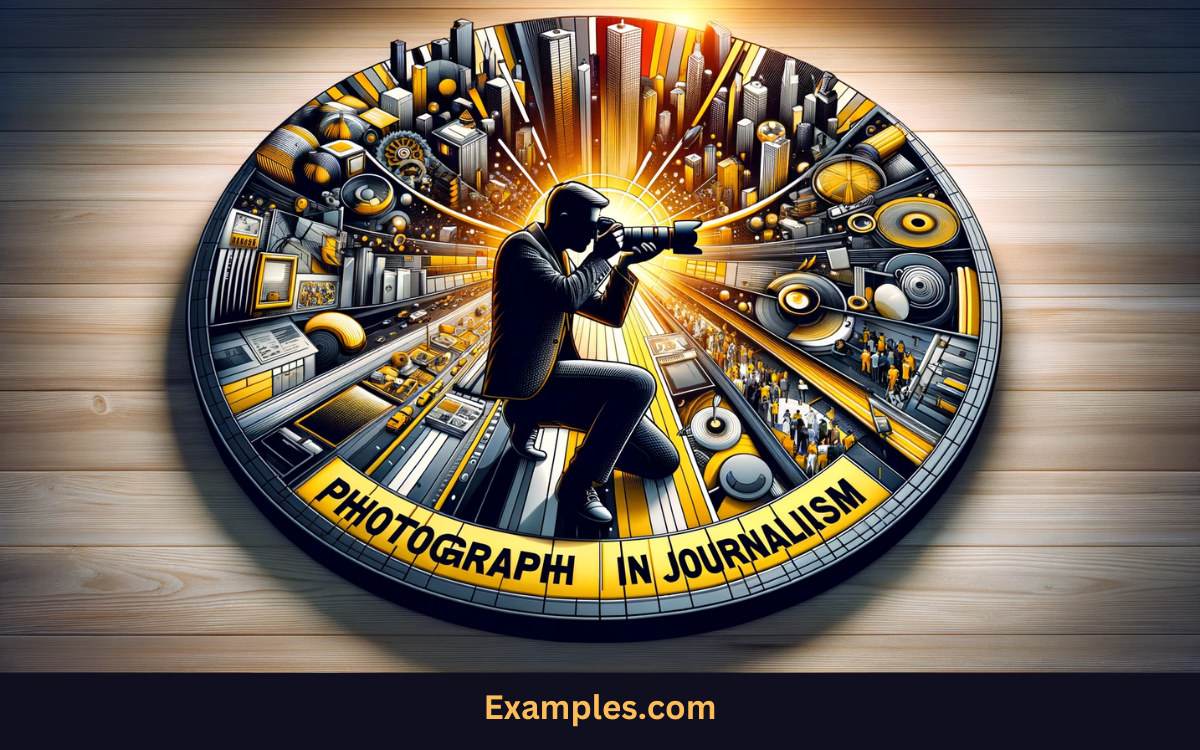
- Educational Content Gatekeeping: Educators choose material that aligns with curriculum standards.
Example: “This textbook provides the most comprehensive coverage for our syllabus.” - Corporate Communication Control: Companies manage internal information flow.
Example: “We need to ensure our internal newsletter aligns with our corporate messaging.” - Fashion Industry Trends: Editors determine what fashion trends to highlight.
Example: “This season, sustainability in fashion should be our focal point.” - Political News Filtering: Media outlets select political news based on audience bias.
Example: “Our viewers lean towards conservative views; let’s prioritize related news stories.” - Health Information Dissemination: Health organizations decide which information to release to the public.
Example: “It’s important to communicate these health guidelines clearly to ensure public safety.” - Cultural Content Gatekeeping: Cultural institutions decide which cultural narratives to promote.
Example: “This exhibit will highlight underrepresented cultures in our community.”
Role of Gatekeeping Theory in Mass Communication
Gatekeeping Theory plays a crucial role in understanding the dynamics of information dissemination in mass communication. Here are its key aspects:
- Control of Information Flow: Gatekeepers, such as editors and producers, have the power to decide what information reaches the public. This decision-making process significantly influences the Mass Communication Scenario/ Situation.
- Influence on Public Opinion: The information selected by gatekeepers can shape public opinion. By choosing certain topics over others, they highlight specific issues, thereby guiding the audience’s perception and discussions.
- Impact of Digital Media: With the advent of digital and Social media Mass Communication, the role of traditional gatekeepers has transformed. Now, algorithms and user preferences also act as gatekeepers, determining what content is displayed to users.
- Ethical Considerations: Gatekeeping raises questions about bias and ethics. The subjective nature of decision-making can lead to a skewed representation of reality, affecting the Mass Communication Examples in Journalism and other fields.
- Adaptation to New Media Forms: Gatekeeping theory is continually adapting to new forms of media. For instance, in Television Mass Communication and online platforms, gatekeepers must balance commercial interests with informational integrity.
- Gatekeeping in Crisis Situations: During crises, gatekeepers play a vital role in disseminating accurate information, thus impacting public response and policy.
- Filtering of Information: The process of selecting news items from a vast pool of information is crucial. This filtering process determines the priority and significance assigned to different news stories.
- Feedback Mechanism: The audience’s response and feedback can influence gatekeepers, creating a dynamic interplay between the media and its consumers.
- Professional Responsibilities: Gatekeepers often face the challenge of maintaining journalistic integrity while meeting organizational objectives, such as attracting viewership or readership.
- Representation of Diverse Voices: Gatekeeping theory also underscores the importance of representing diverse voices and perspectives in the media, avoiding biases and promoting inclusivity.
Gatekeeping Theory remains an essential concept in mass communication, offering insights into how information is filtered and presented to the public, and the implications this has on society. As media landscapes evolve, the theory continues to adapt, providing a framework for analyzing the complex interactions between media producers, content, and audiences.
Importance of Gatekeeping Theory in Mass Communication
- Understanding Media Influence: Gatekeeping Theory highlights how media control over information affects public knowledge and opinion.
- Analyzing News Bias: It helps in identifying biases in news reporting, ensuring a more critical consumption of media.
- Influencing Public Agenda: The theory illustrates how media can set the public agenda by prioritizing certain topics over others.
- Reflecting Cultural and Social Values: Gatekeepers often select content that aligns with societal norms and values, reflecting and reinforcing cultural biases.
- Adapting to Digital Media: With the rise of digital platforms, understanding gatekeeping is crucial in analyzing the changing landscape of media control and dissemination.
How to Use Gatekeeping Theory in Mass Communication
- Content Analysis: Media professionals can use the theory to analyze and ensure a balanced representation of news and information.
- Policy Making: Understanding gatekeeping helps in formulating policies for media regulation and ethical journalism.
- Media Literacy Education: Educators can use the theory to teach students about media influence and the importance of critical thinking.
- Audience Awareness: The theory raises awareness among audiences about how their perceptions are shaped by media.
- Strategic Communication: In Public Relations Mass Communication and Advertising, professionals can apply gatekeeping principles to strategically place and frame messages.
- Social Media Strategies: Understanding the new forms of gatekeeping in Social media Mass Communication is essential for effective digital communication.
Gatekeeping Theory remains a critical concept in understanding media influence in today’s information-rich world. It not only offers insights into the workings of traditional media but also provides valuable perspectives for navigating the complex dynamics of digital communication platforms. By applying this theory, professionals in Mass Communication Jobs/Careers and students can develop a more nuanced understanding of media processes and their impact on society.



